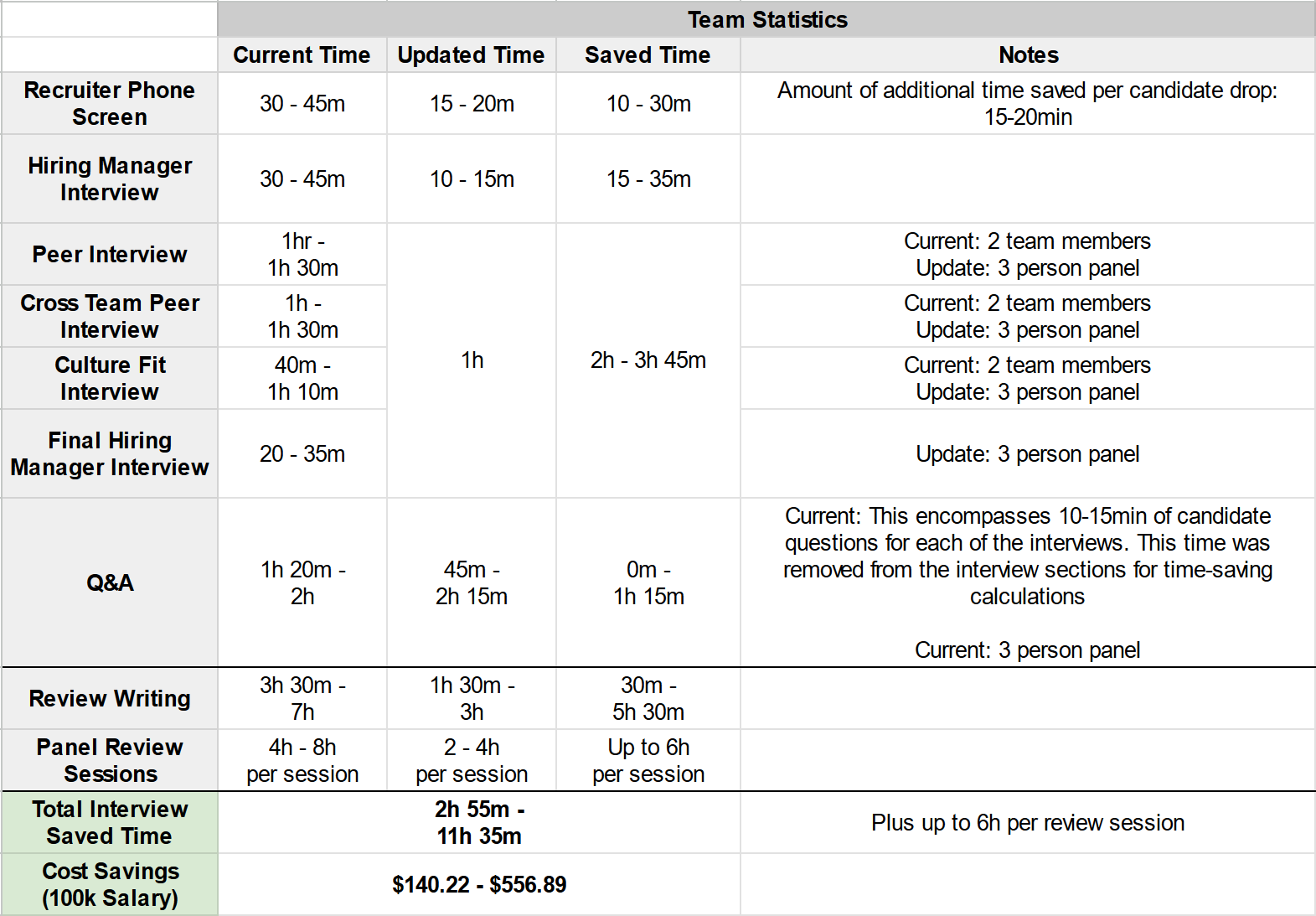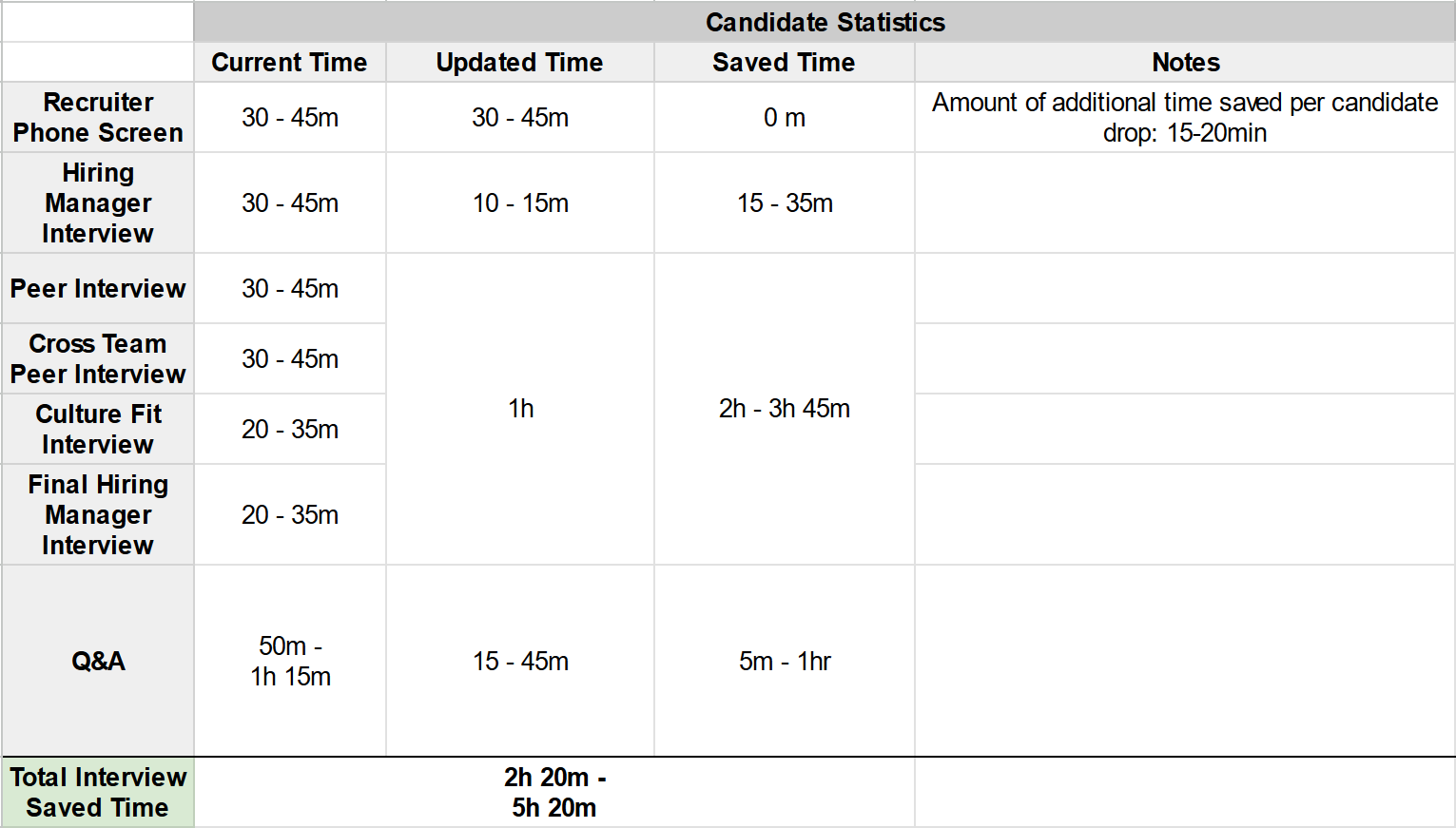Revamping the Interview Process
Posted 7/6/2023
Being laid off in this market was tough, and I learned a lot! One of the topics I think warrants some deep diving into is interviewing. Interviewing is a time-consuming and expensive process for all individuals involved. In the tech industry, having a 4-6 hour interview process is not abnormal. This can be spread across several days or fall into one day. This also doesn't include time spent on applications, job description preparation, interview prep, take-home assessment completion and reviews, written reviews, or candidate review panels. By the time everything is considered, candidates spend about one workday on each role they interview for, and the company also pays for that.
On top of that, most people are not indeed themselves during an interview. National Institute of Mental Health studies show, "An estimated 31.1% of U.S. adults experience any anxiety disorder at some time in their lives." This means about one in every three candidates is likely struggling through their interview with above-average anxiety while trying to present themselves at their best.
So how can we improve our interviewing process to be more accommodating, less time-consuming, and less expensive? While this may be an unpopular opinion, I have outlined a possible approach below to accomplish all of this.
Current Interviews
While every company I interviewed with did differ slightly in their interviewing approach, there is a basic pattern that most companies seem to follow:
- 30 - 45min Recruiter Phone Screening
- Take Home Assessment
- 45min - 1hr Hiring Manager Interview
- 45min - 1hr Peer Interview
- 45min - 1hr Cross Team Peer Interview
- 30 - 45min Culture Fit Interview
- 30 - 45min Final Hiring Manager Interview
This is a lot of time, and most companies have more than one person in their peer, cross-team, and culture fit interviews, so that time doubles for the company. On the low side, this is 3 hours and 45 minutes in interviews, and on the high side, it's 5 hours 15 minutes. This also isn't considering the take-home assessment time. Let's see where we can improve this interview process and save the company time and money while saving the candidate some time.
Recruiters have a critical job. They are sifting through hundreds, and potentially thousands, of applications, resumes, cover letters, and portfolios, trying to find a candidate that seems to fit the job description well. After identifying potential candidates, they contact each one for phone screening availability. They then check the calendar, set up the time, and when the day comes, they hop on a phone call that averages out to be around 30 minutes. During these interviews, recruiters are likely very repetitive in the topics they discuss:
- Salary Expectations
- Company Benefits
- High-Level Role and Company Overview
- Asking what the candidate is looking for in their next role
- Answering some basic questions, the applicant has
Recruiting
Idea: Automate this portion of the interview. Let's decrease the amount of time recruiters spend talking with candidates.
Step 1: Email the candidate showing interest as you always have. Ask them to watch the attached pre-recorded recruiter video, which includes salary expectations, company benefits, high-level role and company overview, and answers to frequently asked questions. This video will be about 15-20 minutes.
Step 2: If the candidate is interested in the role after watching the recruiter video, their task is to record a camera-on video about what they are looking for in their next role and answers to any other provided baseline questions the recruiter has. The time limit for this is 15-20 minutes, and candidates are expected to respect that time limit.
Step 3: The recruiter reviews the videos for those who submitted them and determines which candidates will move forward.
Throughout this process, candidates can always email the recruiter with questions they may have and need answering before our Q&A session later.
Pros:
- Recruiters save 15-25 minutes on all interviews, gaining that time back in their day for other responsibilities
- Candidates who learn about the company, salary, and role but do not feel the job is the right fit for them will not respond with a 15-20 minute video, saving the recruiter an additional 15-20 minutes on those interviews
- Candidates can be more relaxed since they can record and re-record their responses until they are satisfied. You will get to see their true self more
Cons:
- Interviews become more directed Q&A and less conversational
- Requires interview process to be remote
- Candidates are required to have a video camera and software that allows for recording themselves
Candidates that make it through the recruiting phase move into the hiring manager phase. While the hiring manager leads this portion, a panel will review responses to help avoid unintentional bias. One thing many companies are not good at is interviewing all candidates the same. Questions change from one to another, and open conversations lead to only one or two questions being answered by one candidate while another responds to four or five. Time management on responses can be challenging because the candidate doesn't know all of the questions that will be asked to understand what to dive into and what to give a shorter answer to. We also put candidates on the spot, hoping for well-thought-out answers. As someone who generally needs a little thinking time, I've encountered the issue of underselling myself due to interviewing nerves and forgetting projects and processes I've worked on. It's tough as a candidate!
Hiring Manager
Idea: This second round will be very similar to the first. We will automate this portion of the interview to decrease the time hiring managers and peers spend in the interviews.
Step 1: The hiring manager records a 10-15 minute intro about themselves and their management style and answers some frequently asked questions for this interview level. This is emailed to the candidate along with a list of ten questions the candidate will answer. Candidates are also informed on the panel of individuals reviewing their answers.
Step 2: If the candidate is still interested in the role after watching the hiring manager video, they must record a camera-on video answering the ten provided questions. The time limit for this is 1 hour, and candidates are expected to respect that time limit. Candidates can edit their video to piece 1 hour together or have a full 1 hour non-stop video.
Step 3: A panel reviews the video - see details in the next section
Pros:
- Candidates have time to think about their answers before answering. They may research and gather data to answer a question, but this should be seen as a positive since it shows resourcefulness and self-reliance.
- Typically interviews span across up to 5 separate sessions after the recruiter phone screen. Asynchronous 1-hour video responses save 2 hours - 3 hours and 45 minutes per interview
- Hiring managers are saving 10-35 minutes on all interviews, gaining that time back in their day for other responsibilities
- Schedule conflicts no longer impact when interviews can occur
Cons:
- Q&A is removed from this portion of the interview
- Interviews become more directed Q&A and less conversational
- Candidates are required to have a video camera and software that allows for recording themselves
You likely already have some form of the review panel you utilize. Typically anyone who interviews also gives a review of the candidate and a decision for whether they would hire that candidate or not. After that, the interview team is brought together to discuss all candidates who are potential hires and whether to hire or continue forward with additional interviews. Many companies have the recruiter, hiring manager, two peers, two cross-team peers, and two culture-fit interviewers involved in these decisions. Because of this, the time spent on writing reviews takes between 3 hours and 30 minutes - 7 hours, and the panel review sessions take 4hr - 8hr of total company time. Following the approach above, where we drop these interviews to be a recorded 1 hour, let's talk about how the review panel should be set up.
Review Panel
Idea: The review panel should comprise 3-6 individuals and be static throughout hiring for that particular role to allow for fair candidate comparisons. Ideally, it would be best to keep the panel at three individuals when considering cost and time savings, but there may be situations where more individuals are best depending on the role. The 3-person panel should consist of the following:
- Hiring Manager
- One Peer
- One Cross-Team Peer
Additional panel members are at your discretion for what roles you'd like to include.
The goal of the review panel is to watch the 1-hour candidate-submitted video. This can be done asynchronously or as a group, but asynchronously provides the most flexibility and less disruption to daily work. After each panel member has watched the video, they will submit a review discussing strengths, growth opportunities, company culture fit, team fit, coachability, and other vital points. They will also determine, from their standpoint, if this candidate is a strong no, no, yes, or strong yes. These decisions and notes will remain anonymous to other panel members until all members have submitted their reviews.
The panel can discuss candidates further in a review meeting for candidates the hiring manager may be on the fence about after seeing the reviews or, with help deciding between multiple strong candidates. This is not required if one candidate is the obvious choice, but we regularly see that isn't the case, and tough decisions must be made.
Pros:
- When using a 3-person panel, review writing saves 30 minutes - 5 hours 30 minutes of company time per candidate
- When using a 3-person panel, review sessions save up to 6hr of company time per session
- Interviews become less disruptive to team members since most of the interview process can be done asynchronously, allowing team members to find a time that works for them
Cons:
- By limiting the panel to 3 individuals, the hiring manager is working off of fewer points of view when hiring someone
- The panel may not feel they know the candidate as well due to the format of the Q&A, and this may lead to uncertainty in candidate decisions
Typically, during an interview, candidates are allotted 10-15 minutes per interview to ask questions so they can learn more about the company. This is an excellent way for candidates to learn about the team, culture, current processes and tools, and expectations that may need clarifying. It generally helps the candidate understand if this company and role are the right fit for them. The problem with this is, with six different interviews taking place and the expectation that questions are asked in every interview, this process can become repetitive with repeat questions not adding value to the candidate, and this time stacks up when you're talking about the company's time and money for all individuals involved in those interviews.
Q&A Session
Idea: The recruiter, hiring manager, and at least one peer will be part of the live Q&A session. The goal of this session is to allow the candidate time to ask the panel questions to ensure the company and role is the best fit for them. This can be a camera on or off session, whatever the candidate is most comfortable with.
Step 1: Email the candidate informing them of the Q&A session expectations, who will be attending, and ask them how much time they would like to have for the session ranging from 15 - 45 minutes. Candidates can also skip the Q&A session if they do not have any questions they'd like to ask.
Step 2: During the session, briefly introduce yourselves to the candidate and then hand over the control to the candidate for them to begin asking questions. When the allotted time is up, or the candidate no longer has questions to ask, the session concludes.
Pros:
- This session can create conversational points if the candidate chooses, adding to getting to know the candidate better and helping with hiring decisions.
- Stress decreases since the candidate knows this portion is all about what they want to know, and they will not be questioned on their knowledge.
- Candidates are always allotted time to ask questions, whereas, in regular interviews, this can be cut short due to the first part of the interview taking longer than expected.
- By keeping the Q&A group small, we protect company time and money by allowing employees to gain that time back in their day for other responsibilities.
- Candidates will not feel the need to ask filler questions in interviews or repeat questions in interviews that do not add value to them
Cons:
- This session is held after the asynchronous interview, which means an ideal candidate may get to the end of the interview cycle and determine the role isn't a good fit for them.
- The candidate may have fewer questions than in typical interviews due to the lack of conversational back and forth from this interview approach.
Overall Statistics
To summarize the time and cost savings, I've broken down each area of the interview below for both the team members and the candidate. As you will see, this approach can save the company a substantial amount of time and money per fully interviewed candidate and also eases the time candidates spend during interviews. While this is an easy way to quantify the improvements this approach can bring, it's important to remember it also helps all candidates who may struggle with presenting themselves in their best form during a typical interview session.
Grand Total Time Savings per Full Interview: 2h 55m - 11h 35m
$140.22 - $556.89 per interview savings (based on 100k salary)
Amount of additional time saved
- per candidate drop during Recruiter phase: 15 - 20m
- per review session: Up to 6h








